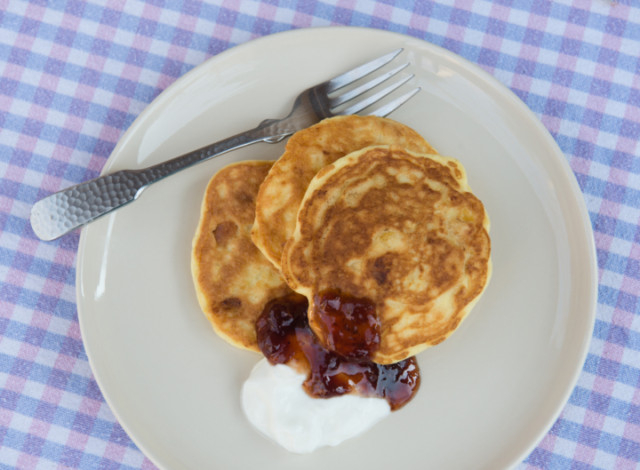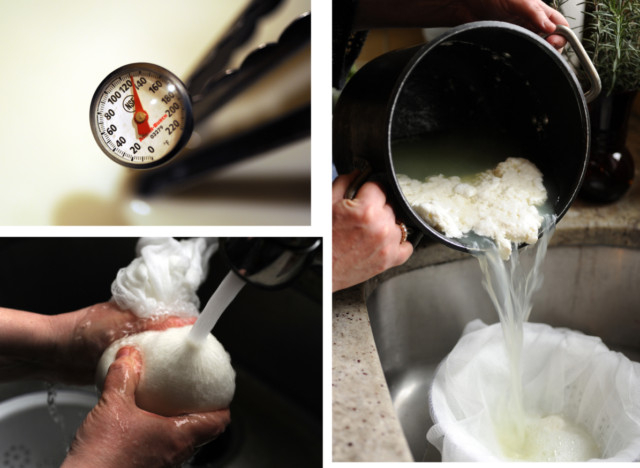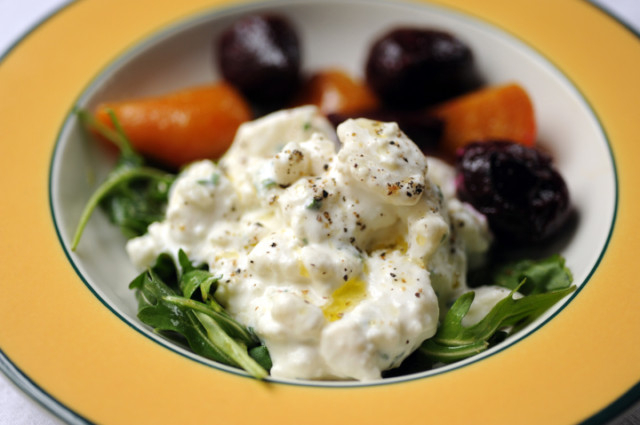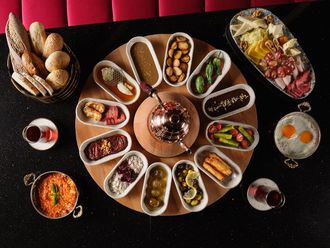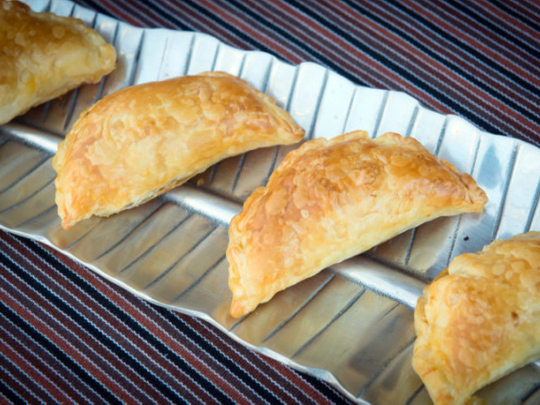
Darn you, modern convenience. For every good measure wrought upon foodstuffs, an equal number of indignities have been suffered. Ravioli in a can. Bread raised only to live in plastic bags on a shelf. Spray cheese! Generations weaned without the benefit of farmers, market artisans or great-aunts who put up jams and pickles are unaware of a universe of true textural delights.
Among the slighted, cottage cheese has been dealt an especially tough hand. Its small and mealy curds are suspended in a sour blandness. It has a bad habit of sidling up to syrupy peach slices, and it is appreciated mainly as a protein delivery system.
It wasn’t always that way. Vickie Reh watched her maternal grandmother make a tart and creamy cottage cheese, stirring in snipped scallion tops from the garden. Grace Tholstrup was a farmer’s wife in northern Kansas. After her chores were done and the children were tended to, from the 1950s to the 1970s, she would drive into Concordia to work as a restaurant cook. Reh doesn’t know whether her grandmother made cottage cheese at the restaurant, but diners were so impressed with her plates in general that they sent tips back to the kitchen.
Reh has made cottage cheese just about every other day since 2009 at Buck’s Fishing & Camping in Northwest Washington, where she heads the kitchen. She didn’t have her grandmother’s recipe, so she found one and tweaked it. “I’m a chef who doesn’t invent the wheel,” she says. “I want to produce the perfect wheel.”
Cottage cheese was the first kind of cheese that Sue Conley learnt to make. It was in 1997, in Washington state, before she and Peggy Smith founded Cowgirl Creamery in California. Conley’s instructor was cheese culture expert David Potter. “He was a master cottage cheese maker,” she says. “I had never tasted anything so good.”
It became her sentimental favourite, a hand-made labour of love that Cowgirl produced at a low-key 75kg per week until the end of last year. They called it “clabbered”, which refers to the way the curd was thickened with a blend of cultured cream and milk.
“We haven’t stopped for good,” Conley says resolutely. “Just call it a suspension of production. We need to figure out a way to improve the process.”
Cottage cheese began as a by-product, often derived from making butter. It was allowed to curdle on its own, over days, sometimes helped along with a natural acidic culture. The problem with American cottage cheese began after the Second World War, Conley says. Industrial shortcuts diminished the curd on several levels. Rennet was used to hasten the process of coagulation. The milk dressing was thickened with cornstarch instead of cream, displacing the fresh dairy taste with something sour. Any clabberation, so to speak, went out the window. These days, the best-selling brands use thickeners such as guar gum and carrageenan.
The flavour has also been bred out of the commercial stuff, not unlike what has become of factory-farmed chickens. “Natural flavour” is added to tubs of cottage cheese in the grocery store dairy case. But flavour comes about naturally in hand-made versions.
“Vickie’s has a wonderful taste and chewiness to it,” says Mike Daly, a tax laywer who ate at Buck’s several times a week until he moved away from the Chevy Chase neighbourhood but still eats at the restaurant enough to preserve his regular’s status.
“The only kind I had before was from the supermarket,” he says. “It was boring. What Vickie serves is a completely different dish.”
Daly ordered it with abandon after he asked about the main ingredient. The curds were formed from nonfat milk. Seemed pretty healthful. Trouble was, he didn’t inquire further, and he must monitor and limit his cholesterol intake. Reh uses heavy cream to dress the large, irregular curds; this moves the dish decidedly out of the healthful realm. Consequently, Daly’s cottage cheese ordering at Buck’s has been scaled back to one or two special-occasion splurges a year.
“But I recommend it to people all the time,” he says.
After the recent Sips and Suppers events in and around Washington, co-host and Chez Panisse restaurateur Alice Waters tried a plateful at Buck’s, served simply atop arugula. She loved it, Reh says.
R.W. “Johnny” Apple Jr became a fan of Cowgirl’s artisan cottage cheese when he visited the California creamery in 2001. Besides dipping in repeatedly with a spoon and asking for a pepper grinder, Conley remembers, the New York Times reporter so famous for his gourmandise described the cheesemakers’ version as “what must be the creamery’s greatest treasure — a rich, creamy, subtly tart, triumphantly cheesy cottage cheese that puts soupy commercial rivals to shame.”
Cowgirl used a lactic acid culture and allowed the curds to form overnight or longer, with lots of hands-on attention. That helped create a buttery and lemony goodness and lent the curd a tender chew. Reh has streamlined the process to a few hours without sacrificing flavour.
Heating the gallons of nonfat milk to a temperature slightly higher than other DIY cottage cheese recipes — 130 degrees — creates conditions to achieve a springy raft of off-white curd. A simple pour of distilled white vinegar and a sturdy spoon set things in motion. After a brief respite for the curd, it takes considerable hand strength to squeeze the curd into a cheesecloth-lined ball. The ball is rinsed to remove as much whey as possible, then compressed to extract as much moisture as possible. That pushes the consistency past that of ricotta or even pot cheese, all the way to firm and borderline translucent. A lot of whey is left behind; it can be used for watering houseplants or making bread.
Reh pinches off thumb-size, craggy curds, letting them fall into a large bowl. They could almost pass for packing material — until the cream goes in and the stirring begins. Within minutes, cottage cheese comes to life. In a nod to her grandmother, the self-trained chef folds in tiny emerald circles of chopped chives.
In summer, additions of peak-season tomatoes, grinds of black pepper and a drizzle of olive oil ensure that emptied cottage cheese plates return to the kitchen at Buck’s. At this time of year, Reh pairs her cheese with beets dressed in a lemony vinaigrette and arugula.
Conley likes to eat good cottage cheese like a dip, with salty potato chips. “It’s terrible to say, but it’s really good that way,” she says. That doesn’t sound half as bad as eating it with ketchup. President Nixon did so, a few times a week. Former visiting White House chef John R. Hanny, author of Secrets From the White House Kitchens (La Marque, 2010), says the president ate it solo and as a side dish with steak. His cottage cheese was not made in-house. He preferred the full-fat kind.
“I had to try it for myself” with the ketchup, Hanny says. “And you know, it wasn’t bad. I kind of liked it.”
Of course, your DIY cottage cheese tastes just fine unadorned.
After you make a batch or two, you might vary the size of the curd or see what that slightly lower milk temperature yields. Or you might get curious about how your cottage cheese would perform in a recipe that calls for store-bought. The curds do not disintegrate or soften much, so working it into a savoury pie dough or kugel is not advised. But they do hold up nicely as filling for baked pastries. And what they do for a simple pancake recipe is impressive.
Should you go to the trouble of making it for your little ones? They are probably just as happy to slurp up what you can buy in single-serve containers. It’s all they know of cottage cheese, after all.
But you love them. And you can be part of the generation that brings it back.
Recipes
VICKIE’S COTTAGE CHEESE
Large, chewy curds suspended in chive-studded cream make this a luxurious standout and customer favourite at Buck’s Fishing and Camping in Northwest Washington. Chef Vickie Reh serves it year-round, alongside seasonal vegetables and greens. At this time of year, she pairs it with arugula and baby beets dressed in a lemon vinaigrette.
If you’d like to serve it with fruit or with dessert, omit the chives and black pepper; you might also want to use a different oil.
You’ll need cheesecloth and an instant-read thermometer. And you’ll have plenty of leftover whey, which is good for making bread and for watering/feeding houseplants.
MAKE AHEAD: The curds need to rest in the whey for 30 minutes. The ball of firm curd can be wrapped in plastic and refrigerated for a day or two before it is broken down and added to the cream, but it is best used the same day it is made. The curds need to be added to the cream 1 hour before serving. The assembled cottage cheese can be refrigerated for a day; re-moisten with a bit of added heavy cream before serving.
Makes about 3 1/2 cups (7 servings)
Ingredients:
71/2l nonfat milk
11/2 cups distilled white vinegar
11/2 tbs kosher salt
11/4 cups heavy cream, plus more as needed
1/4 cup finely chopped chives (optional; may substitute scallions)
Freshly cracked black pepper (optional)
Best-quality extra-virgin olive oil (optional)
Heat the milk in a large pot over medium heat to a temperature of 130 degrees; do not walk away from the pot, as it’s important not to overheat the milk. (If the temperature of the milk does exceed 130 degrees, it’s best to start over with fresh milk.) Remove from the heat and add the vinegar, stirring for about 1 minute; a raft of solid curd will form. Cover tightly with plastic wrap and let sit for 30 minutes.
Line a colander with several layers of cheesecloth. Pour the contents of the pot into the lined colander; reserve the whey for another use, if desired (see headnote). Let the drained curds sit for 5 minutes, then compress them in the cheesecloth, forming a ball. Rinse under cool running water until the core is almost cool, squeezing out as much moisture as you can.
Keep squeezing and tightening the cheesecloth to extract as much moisture from the curd as possible. The ball of curd should be quite solid, and uniform in texture and colour; it should have a slightly translucent look, rather than blotches or veins of opaque white.
An hour before serving, pinch off bite-size pieces of the firm curd, letting them fall into a large bowl as you work. Add the salt and chives, if using, then gently fold in the cup of heavy cream until the mixture becomes slightly thickened to form a creamy cottage cheese. Add some or all of the remaining 1/4 cup of cream as needed, keeping in mind that as the cottage cheese sits or when it is refrigerated, more of the cream will be absorbed.
Serve slightly chilled, garnished with the black pepper and a drizzle of the oil, if desired.
Recipe Source:
Adapted by Reh, chef at Buck’s Fishing and Camping in Northwest Washington, from an Alton Brown recipe.
COTTAGE CHEESE PANCAKE
This is Cowgirl Creamery co-founder Sue Conley’s favourite way to use a handmade creamy, large-curd cottage cheese in a recipe. These four-ingredient pancakes take about 20 minutes to make, start to finish.
A helpful rule for beating egg whites, which is called for in this recipe: Their stiffness should correspond to the consistency of the ingredients you fold them into; a heavy cake batter needs stiffer egg whites than a light, more fluid pancake batter.
Serve with sour cream and jam or creme fraiche and smoked salmon.
Makes 6 or 7 small pancakes (2 or 3 servings)
Ingredients:
3 large eggs
3/4 cup large-curd, creamy cottage cheese, preferably home-made (see related recipe)
1/4 cup flour
1/4 tsp salt
Separate the egg whites and yolks, placing the yolks in the bowl of a stand mixer or hand-held electric mixer. Beat on medium speed until thick and pale. Stop and gently stir in the cottage cheese by hand, then the flour and salt.
Place the egg whites in a separate bowl. Beat on medium, then high speed to form fairly stiff peaks that are still moist. Gently fold the whites into the yolk mixture, until just combined. The batter will be lumpy.
Use nonstick cooking oil spray to lightly grease a griddle or heavy skillet. Place over medium-high heat. Drop heaping serving-spoonfuls of the pancake batter, spacing them a few inches apart. Cook for about 2 minutes, until bubbles cover the surface of the pancakes and the undersides are lightly browned. Turn them over and cook for about 2 minutes on the second side. Transfer to a warmed plate; repeat with nonstick cooking oil spray to use all the batter.
Serve the pancakes warm.
Recipe Source:
Adapted from The Pancake Handbook: Specialties From Bette’s Oceanview Diner, by Steve Siegelman, Bette Kroening and Sue Conley (Ten Speed Press, 2003).
Cottage Cheese Empanadas
Large-curd, creamy cottage cheese provides a surprisingly successful base for the filling of these quick snacks. Store-bought cottage cheese can be substituted, but it won’t work quite as well here, because it has more moisture.
The recipe doubles easily. The empanadas are best served just after they are made.
Makes 9 empanadas
Ingredients:
9 store-bought empanada wrappers
1 cup large-curd, creamy cottage cheese, preferably home-made (see related recipe)
1/4 cup chopped unsweetened cranberries (may substitute chopped sun-dried tomatoes, for a more savoury flavour)
1/3 cup pine nuts, toasted (see NOTE)
1 tbs capers, drained and rinsed
50g imported, oil-packed tuna, preferably Spanish
1 tsp aleppo pepper (may substitute sweet paprika)
1 tbs good-quality extra-virgin olive oil
1 large egg yolk, beaten with 2 or 3 tbs water
Preheat the oven to 375 degrees. Line a baking sheet with parchment paper.
Arrange the empanada wrappers in a single layer on a clean work surface.
Gently combine the cottage cheese, cranberries, pine nuts, capers, tuna and aleppo pepper in a mixing bowl. Drizzle with the oil.
Divide the mixture among the wrappers, heaping a small mound at the centre of each one. Brush the egg wash mixture around the edges, then fold over each wrapper to form a half-moon shape. Press or use the tines of a fork to seal the edges. Transfer to the baking sheet; brush the tops with the remaining egg wash. Bake for 20 to 25 minutes, until golden brown.
Serve warm or at room temperature.
NOTE: Toast pine nuts in a small dry skillet over medium-low heat for several minutes, until fragrant and lightly browned, shaking the pan as needed to keep them from burning.
Recipe Source: From deputy Food editor Bonnie S. Benwick.
— Washington Post


